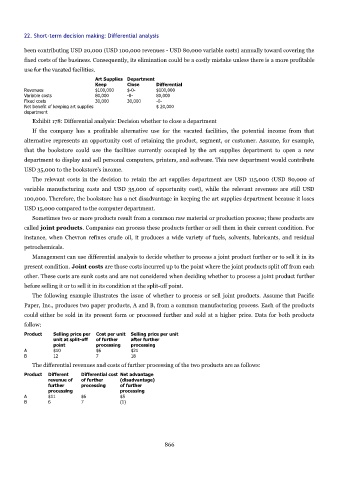Page 865 - Accounting Principles (A Business Perspective)
P. 865
22. Short-term decision making: Differential analysis
been contributing USD 20,000 (USD 100,000 revenues - USD 80,000 variable costs) annually toward covering the
fixed costs of the business. Consequently, its elimination could be a costly mistake unless there is a more profitable
use for the vacated facilities.
Art Supplies Department
Keep Close Differential
Revenues $100,000 $-0- $100,000
Variable costs 80,000 -0- 80,000
Fixed costs 30,000 30,000 -0-
Net benefit of keeping art supplies $ 20,000
department
Exhibit 178: Differential analysis: Decision whether to close a department
If the company has a profitable alternative use for the vacated facilities, the potential income from that
alternative represents an opportunity cost of retaining the product, segment, or customer. Assume, for example,
that the bookstore could use the facilities currently occupied by the art supplies department to open a new
department to display and sell personal computers, printers, and software. This new department would contribute
USD 35,000 to the bookstore's income.
The relevant costs in the decision to retain the art supplies department are USD 115,000 (USD 80,000 of
variable manufacturing costs and USD 35,000 of opportunity cost), while the relevant revenues are still USD
100,000. Therefore, the bookstore has a net disadvantage in keeping the art supplies department because it loses
USD 15,000 compared to the computer department.
Sometimes two or more products result from a common raw material or production process; these products are
called joint products. Companies can process these products further or sell them in their current condition. For
instance, when Chevron refines crude oil, it produces a wide variety of fuels, solvents, lubricants, and residual
petrochemicals.
Management can use differential analysis to decide whether to process a joint product further or to sell it in its
present condition. Joint costs are those costs incurred up to the point where the joint products split off from each
other. These costs are sunk costs and are not considered when deciding whether to process a joint product further
before selling it or to sell it in its condition at the split-off point.
The following example illustrates the issue of whether to process or sell joint products. Assume that Pacific
Paper, Inc., produces two paper products, A and B, from a common manufacturing process. Each of the products
could either be sold in its present form or processed further and sold at a higher price. Data for both products
follow:
Product Selling price per Cost per unit Selling price per unit
unit at split-off of further after further
point processing processing
A $10 $6 $21
B 12 7 18
The differential revenues and costs of further processing of the two products are as follows:
Product Different Differential cost Net advantage
revenue of of further (disadvantage)
further processing of further
processing processing
A $11 $6 $5
B 6 7 (1)
866

